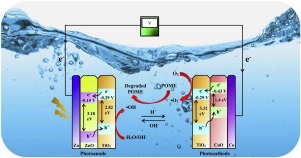Journal of Photochemistry and Photobiology A: Chemistry ( IF 4.1 ) Pub Date : 2019-12-31 , DOI: 10.1016/j.jphotochem.2019.112353 Ming-Wei Kee , Sze-Mun Lam , Jin-Chung Sin , Honghu Zeng , Abdul Rahman Mohamed

|
A sustainable green device known as photocatalytic fuel cell (PFC) uses organics found in wastewater as fuel for the energy conversion. Hence, the effective PFC constructing from anodic TiO2/ZnO/Zn and cathodic TiO2/CuO/Cu was proposed for refractory palm oil mill effluent (POME) removal as well as energy recovery. Among the as-prepared photoanodes, anodic ZnO/Zn coated with 2 layers of TiO2 (TZ2) showed high crystallinity, low band gap, appropriate hydroxyl group and interfacial charge carrier separation that enable its superior photoactivity, which presented an enhancement of 3.67 times and 4.64 times in photocatalytic and energy performance over pristine ZnO/Zn. Among several examined influential parameters, the electrolyte concentration was the most influential factor due to its provision of OH− ions that can capture the photogenerated holes to enhance the electron-hole pair separation. The optimized system reached 90 % of COD removal efficiency of POME. Furthermore, an open circuit voltage (Voc), short circuit current density (Jsc) and power density (Pmax) of 1173 mV, 0.2652 mA cm-2 and 0.0734 mW cm-2 was achieved, respectively. The photoanode maintained high recyclability performance after repeated experimental cycles. In-depth mechanism investigations confirmed that the marked cell performance was attributed to not only the accelerated charge carrier separation due to deposition of TiO2 onto ZnO/Zn as verified by the photoelectrochemical tests, but also the dominant active species, including hydroxyl ( OH) radicals and hole (h+) found in the radical trapping study. The assessed electrical energy efficiency of PFC using anodic TZ2 manifested reduced energy consumption of 1.77 times as compared to PFC using pristine anodic ZnO. The toxicity experiments via wild algae indicated reduction in toxicity. This work advances the practical application of promising PFC for environmental protection and energy recovery.
OH) radicals and hole (h+) found in the radical trapping study. The assessed electrical energy efficiency of PFC using anodic TZ2 manifested reduced energy consumption of 1.77 times as compared to PFC using pristine anodic ZnO. The toxicity experiments via wild algae indicated reduction in toxicity. This work advances the practical application of promising PFC for environmental protection and energy recovery.
中文翻译:

阳极氧化TiO 2 / ZnO / Zn光催化燃料电池中改善电荷棕榈油厂废水处理和同步发电的电荷转移动力学
一种称为光催化燃料电池(PFC)的可持续绿色装置,将废水中的有机物用作能量转换的燃料。因此,提出了由阳极TiO 2 / ZnO / Zn和阴极TiO 2 / CuO / Cu构成的有效PFC,用于去除耐火棕榈油厂废水(POME)和回收能量。在准备好的光阳极中,阳极氧化锌(ZnO / Zn)涂有2层TiO 2(TZ2)表现出高结晶度,低带隙,合适的羟基和界面电荷载流子分离,使其具有出色的光活性,与原始ZnO / Zn相比,光催化和能量性能提高了3.67倍和4.64倍。在几种检查有影响的参数,电解质浓度是最有影响力的因素,因为它提供的OH -离子,其可以捕获光生空穴来提高电子-空穴对分离。优化的系统达到了POME去除COD效率的90%。此外,还有开路电压(V oc),短路电流密度(J sc)和功率密度(P max)。)达到1173 mV ,分别达到0.2652 mA cm -2和0.0734 mW cm -2。经过反复的实验循环,光阳极保持了较高的可回收性。深入的机理研究证实,显着的电池性能不仅归因于通过光电化学测试证实的TiO 2沉积在ZnO / Zn上,从而加速了载流子分离,而且还归因于主要的活性物质,包括羟基( OH)自由基和空穴(h +)在自由基诱捕研究中发现。使用阳极TZ2评估的PFC的电能效率表明,与使用原始阳极ZnO的PFC相比,能耗降低了1.77倍。通过野生藻类进行的毒性实验表明毒性降低。这项工作推动了有前途的PFC在环境保护和能源回收方面的实际应用。
OH)自由基和空穴(h +)在自由基诱捕研究中发现。使用阳极TZ2评估的PFC的电能效率表明,与使用原始阳极ZnO的PFC相比,能耗降低了1.77倍。通过野生藻类进行的毒性实验表明毒性降低。这项工作推动了有前途的PFC在环境保护和能源回收方面的实际应用。











































 京公网安备 11010802027423号
京公网安备 11010802027423号